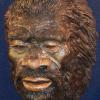I have no issue with that, I'd agree ... deer sheds are pretty common. That misses part of the point I tried to make. How many bigfoots should we assume are in Oregon just for the purposes of doing faux-math? Maybe 200? If they live 40 years on average, how many die each year? 5? Oregon has just passed 4 million people. How many dead bodies are found, outside of populated areas, other than during a formal search for the body so that someone just randomly finds someone not known to be missing? A dozen? Two dozen? See the proportions / scaling issue relative to assumption someone should just stumble over one?
Think about burial situations. To be buried there has to be someone to do the burying. If they do bury at all, it implies some sort of social structure. In that sort of setting, it's less likely the very young or very old would be out alone. Those are the most likely to die. Those who did venture out alone would be the most healthy, most fit, least likely to die other than by accident.
Even without burial, the numbers available to find are very low, and with burial, it drops to near nothing in a hurry, only accidental death of the most fit, most capable. A place risky for a bigfoot for accidental death might be pretty risky for us, too, reducing the number of people who might go there to find a body. (Agree? Disagree?)
In other words, without burial, the number of bigfoots to find dead is low. If they do bury their dead, that number drops to .. 1 a year n my whole state maybe? And probably in a place nobody would be to look?
This doesn't take weird "logic", it doesn't take "woo", it just takes understanding the numbers involved, the behaviors of people, then clearly thinking through the problem without preconceived ideas interfering.
MIB



